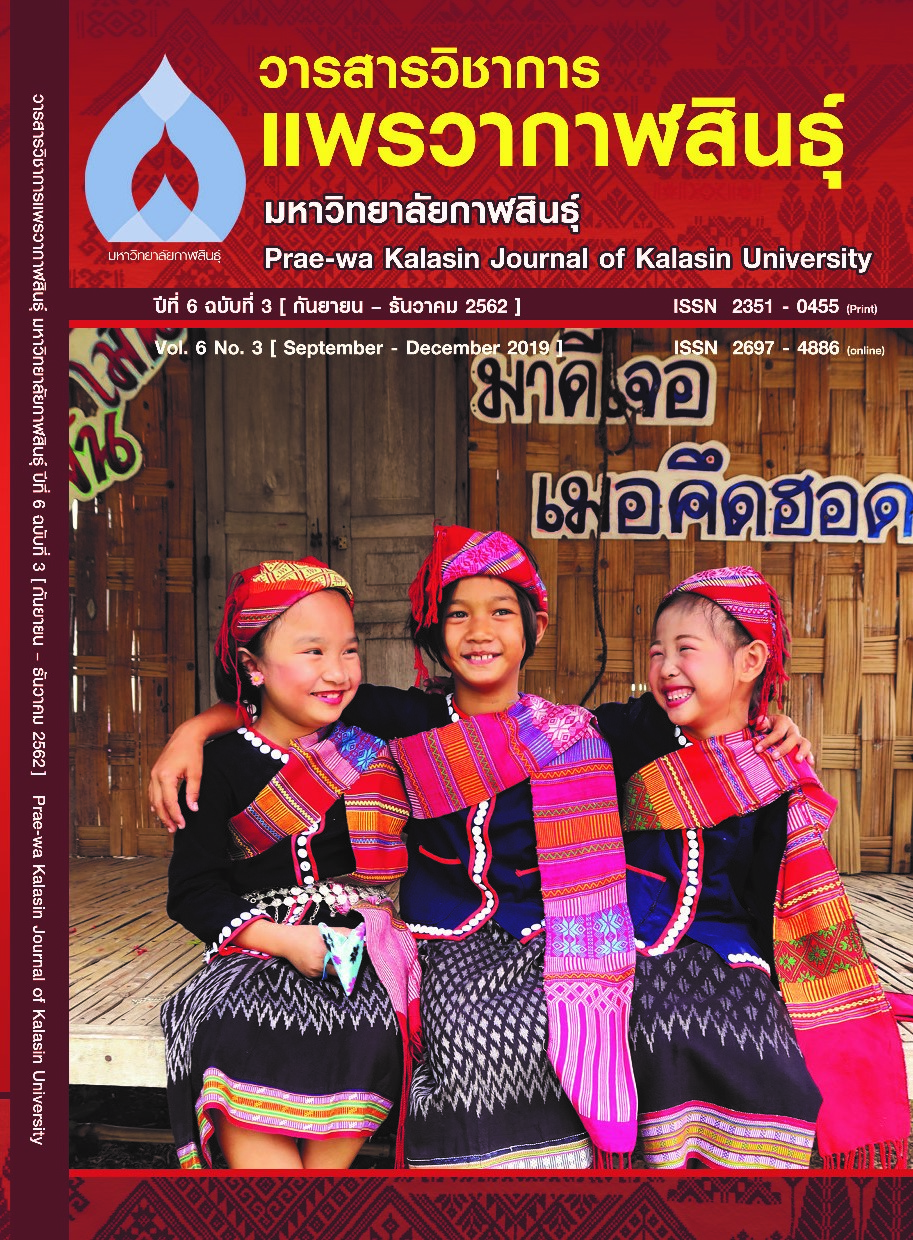Development of participation according to the creative economy concept In tourism management Cultural Road Muen San community Chiang Mai Province
Main Article Content
Abstract
The purposes of this research were to 1) study the cultural identity and wisdom of the Muen Sarn community, 2) study the conditions and needs of tourism management of the Muen San community culture road 3) develop participation in accordance with the creative economy concept in tourism management Muen San Community Culture Street The sample group used in the research was people in the ten thousand people community. Si Suphan Temple Community And Nantharam community, 98 people, using the specific selection method Which is a qualitative research By researching, R&D, collecting by using survey, interview, observation, group discussion and descriptive data analysis, the results showed that 1) The community is unique in culture, art, music, dance and silver Wua Lai. 2) The community has tourist attractions in arts, culture, traditions, religions, history, wisdom and economic development. But the route of the Muen Sarn culture road does not appear to organize activities or shops Making it not very popular with tourists And unsuccessful in tourism management The community wants to develop tourism management through participation in the concept of creative economy. 3) The community is able to manage tourism in the form of tourism management by participation of the community in accordance with the concept of creative economy and the maximum utilization of resources in the community.
Article Details
References
กรมการท่องเที่ยว. (2553). แผนยุทธศาสตร์การท่องเที่ยวอาเซียน พ.ศ. 2554-2558 (ASEAN Tourism Strategic Plan 2011-2015. สืบค้น 7 พฤษภาคม 2559 จากhttp://www.tourismkm-
asean.org/wp-content/pdf/Plan- ASEAN Tourism/Final_ASEAN Tourism_Strategic_Plan_ Thai_version.pdf
Department of Tourism. (2010). ASEAN Tourism Strategic Plan 2011-2015 (ASEAN Tourism Strategic Plan 2011-2015. Retrieved 7 May 2016 from http: //www. tourismkm-asean.org/wp-content/pdf/Plan- ASEAN Tourism / Final_ASEAN Tourism_Strategic_Plan_ Thai_version.pdf
กรมพัฒนาชุมชน. (2550). ประวัติความเป็นมาผลิตภัณฑ์ 1 ตำบล 1 ผลิตภัณฑ์ กรมพัฒนาชุน กระทรวงมหาดไทย. กรุงเทพฯ: ศูนย์ราชการเฉลิมพระเกียรติ กรมพัฒนาชุมชน.
Department of Community Development. (2007). History of the product 1 Tambon 1 Product Department of Development Ministry of the Interior. Bangkok: Chalerm
Phrakiat Government Center Department of Community Development.
กาญจนา แสงลิ้มสุวรรณ และ ศรันยา แสงลิ้มสุวรรณ. (2555). การท่องเที่ยวเชิงมรดกวัฒนธรรมอย่างยั่งยืน. วารสารนักบริหาร. ปีที่ 32 ฉบับที่ 4 (ตุลาคม - ธันวาคม 2555), หน้า 139-146.
Saenglimsuwan Kanchana and Saenglmsuwan Saranya. (2012). Cultural heritage tourism such as Sustainable. Executive Journal. Year 32, Issue 4 (October –
December 2012), Page 139-146.
จุณณเจิม ยุวรี และคณะ. (2551). มนุษย์กับสังคม. กรุงเทพฯ: คณะมนุษยศาสตร์และสังคมศาสตร์ มหาวิทยาลัยราชภัฏสวนดุสิต.
Yuvaree Junnajerm and the other (2008). Human and Society. Bangkok: Faculty of Humanities and Social Sciences Suan Dusit Rajabhat University
นวยนาด เชาวนาภรณ์. (2552). แนวทางการพัฒนาเศรษฐกิจชุมชนในแหล่งท่องเที่ยวโบราณสถาน บ้านปราสาท จังหวัดนครราชสีมา. วิทยานิพนธ์ ศิลปศาสตรมหาบัณฑิต สาขาวัฒนธรรมศาสตร์ คณะวัฒนธรรมศาสตร์ มหาวิทยาลัยมหาสารคาม.
Chaowanaporn Nwynad. (2009). Community Economic Development Guidelines for Historic Sites Prasat House, Nakhon Ratchasima Province. Master of Arts Thesis
Culture Faculty of Culture Mahasarakrm university.
นุจรินทร์ ทับทิม. (2553). การสื่อสารอัตลักษณ์ของชุมชนบ้านวัวลาย จังหวัดเชียงใหม่ ผ่านกิจกรรม ถนนคนเดิน. วิทยานิพนธ์ ศิลปศาสตรมหาบัณฑิต สาขาวิชาการสื่อสารศึกษา คณะการสื่อสารมวลชนมหาวิทยาลัยเชียงใหม่.
Thubthim Nucharin. (2010). Identity communication of Ban Wua Lai community. Chiang Mai Province through activities Walking street. Master of Arts thesis Communication Studies Program Faculty of Mass Communication, Chiang Mai University.
สมคิด พรมจุ้ย และ สุพักตร์ พิบูลย์. (2552). การพัฒนาชุดฝึกอบรมทางไกล เรื่อง การวิจัยและพัฒนางานวิชาการ. นนทบุรี: มหาวิทยาลัยสุโขทัยธรรมธิราช.
Promsui Somkid and Pibun Sukha. (2009). Development of distance training packages on research and development. Academic work. Nonthaburi: Sukhothai
Thammathirat Open University.
สมภพ สายมา. (2555). การจัดการการท่องเที่ยวเชิงอนุรักษ์ที่เหมาะสมกับชุมชนบ้านศรีนาป่าน ตำบลเรือง อำเภอเมือง จังหวัดน่าน. วิทยานิพนธ์ วิทยาศาสตรมหาบัณฑิต สาขาการพัฒนาภูมิสังคมอย่างยั่งยืน คณะผลิตกรรมการเกษตร มหาวิทยาลัยแม่โจ้.
Saima Somphob. (2012). Ecotourism management suitable for Ban Srinaphan community, Rueang Sub-district Muang District, Nan Province. Master of Science Thesis
The branch of geopolitical development like Sustainable Agriculture Board Maejo University.
สุดชีวัน นันทวัน ณ อยุธยา. (2551). การจัดการการท่องเที่ยว เชิงวัฒนธรรมโดยชุมชนเป็นศูนย์กลาง กรณีศึกษา อำเภอเมือง จังหวัดเชียงใหม่. การค้นคว้าแบบอิสระ ศิลปศาสตรมหาบัณฑิต สาขาวิชา เศรษฐศาสตร์การเมือง คณะสังคมศาสตร์ มหาวิทยาลัยเชียงใหม่.
Nantawan Na Ayutthaya, Sudchewan. (2008). Tourism Management Cultural in a community-centered way A case study of Mueang District, Chiang Mai
Province. Independent research Master of Arts Program in Political Economics Faculty of Social Sciences Chiang Mai University.

